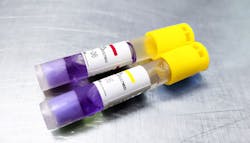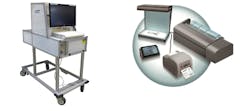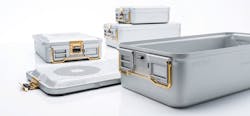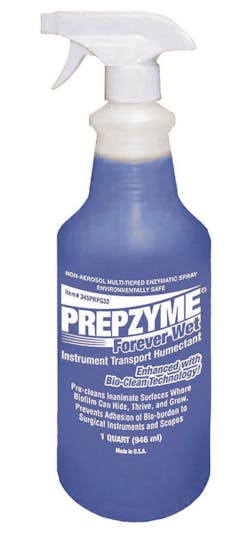Assess and assure quality in every step of sterilization process
Maintaining a high level of quality in a healthcare setting is always a challenge given the many factors that can disrupt standard processes and sometime require staff members to divert from established protocols. While nobody wants to admit it, an emergency case might require operating room (OR) and central sterile/sterile processing department (CS/SPD) staff members to streamline processes in order to provide immediate care to the patient on the table.
This has been especially true during the COVID-19 pandemic, where a sudden surge in SARS-CoV-2 virus cases and depletion of personal protective equipment (PPE) have forced healthcare staff members to engage in practices that would be considered taboo in times of “business as usual.” In the CS/SPD, staff have found themselves using equipment normally intended for the reprocessing of surgical instruments to reprocess disposable N95 respiratory masks for reuse.
The pandemic is by no means over, but surgical cases have resumed out of necessity to care for non-virus patients. Healthcare staff members have been challenged with maintaining high quality levels in care delivery during these unprecedented times. In the CS/SPD, some professionals have taken the opportunity to evaluate the processes they have in place for quality and sterility assurance and make improvements to increase efficacy and safety. In many cases, quality/sterility assurance best practices can boost process efficiency as well, enabling the CS/SPD to deliver safer and more effective instruments to customers faster.
The big picture
“A continuous quality improvement program takes into consideration the entire process pathway, which would include decontamination, cleaning, preparation, packaging, sterilization, quality control (monitors), storage and distribution,” said Harmer. “Your organization should be conducting an ongoing risk analysis for all aspects of your processing. The identification of any risk is integral to prevent any risk that could occur to staff or personnel. Risk stratification is integral to the identification of risk areas, quantifying the risk and the identification of any actions that could be taken to prevent or resolve the risk.”
Harmer says education and training will assist staff in understanding how to identify a risk, provide a plan, prevent the risk or resolve the risk. Therefore, those conducting the risk assessment should communicate to staff members whether the risk has been prevented or resolved.
“Typically, risk analysis is performed at least annually,” said Harmer. “With COVID-19, there was the necessity to look immediately at risks for the department’s processing activities. For example, supply chain management issues were overwhelming for CS/SPD; to name a few, the lack of PPE, detergent solutions and wipes, processing supplies; with lockdowns, the inability for service representatives and sales representatives to offer maintenance and information onsite. Staffing is a daily consideration in CS/SPD but inadequate staffing was evidenced by staff or a staff member’s family becoming positive and the staff member could not come to work.”
An ounce of prevention
Addressing quality issues before they impact care is critical. That’s why CS/SPD professionals should take the time to inspect instruments and perform preventative maintenance to avoid issues down the road. But pressures from the OR to turn around sets faster for a growing number of procedures makes it extremely challenging for CS/SPD staff to find the time to perform these proactive tasks.
“Thorough inspection of instruments during tray assembly and careful documentation of instrument set contents are essential for quality tray assembly,” said Lawrence Zelner, President, RST Automation. “All too often technicians shortcut the inspection process because of time pressure due to labor shortages and large swings in workload. Missing instruments and incorrect instruments are other problems that result from shortcutting the instrument verification process required by contemporary computerized instrument management systems.”
“Increasing complexity of surgical instrumentation, unclear, incomplete or missing instructions for use (IFU), overloaded surgical sets and overburdened SPD staff are just some of the contributing factors that lead to inadequate cleaning and inspection of surgical instruments, resulting in increased bioburden risks,” said J Schrader, Marketing Director, SPD Products and Services, Aesculap.
“The COVID-19 pandemic has made it more important than ever to carefully inspect instrumentation for bioburden,” Zelner added. “At some hospitals, the pressure of the pandemic has also led to increased labor shortages. Therefore, it is more important than ever before to implement new processes that promote improved quality while assisting technicians to work more efficiently.”
“By proactively inspecting these vital tools, customers can greatly decrease their risk of broken/damaged instruments and potentially damaged containers that can lead to compromised sterility issues,” said Schrader. “It is imperative that the SPD department partner with a repair vendor who offers training, on-site service and a preventative maintenance plan that focuses on all sets, particularly the high-turn trays.”
Manufacturers in the CS/SPD space have introduced new innovations to make it easier for department professionals to perform proactive inspections and preventative maintenance. For example, Aesculap offers Surgical Asset Management programs, including its QuickScan baseline assessment and Process Ready Analysis. This combines tray utilization data with workflow and process observation to develop solutions that streamline inventory and optimize surgical trays, helping to reduce complexity, assembly and inspection errors, and decreased bioburden and contamination risks.
“These best practices are easy to implement and can save the SPD time and money in the long run,” said Schrader. “They can also greatly decrease the risk of sending a set to the OR that has a quality or sterility issue.”
To help CS/SPD technicians assemble surgical instrument sets and packages of individual instruments in a safer, more consistent and more efficient manner, RST Automation has developed its Assisted Instrument Management (AIM) line of products. This includes the AIM Tray Assembly solution, which uses machine vision (MV) technology and artificial intelligence (AI) to automatically identify and verify instruments on the count sheet; and the AIM Peel Pack tool, which uses MV technology and AI to automatically generate sterilization pouches and labels simultaneously.
Tracking and reporting errors
“Based on assessment findings from hospitals across the country, there is significant need for improvement in QA/QC practices,” said Agoston. “The goal should always be that 100 percent of the instruments assembled and sterilized are available when needed, functional and safe to use on the patient. To accomplish 100 percent accuracy on these three critical factors, SPD management must determine the number of inspections that are necessary. These inspections must be conducted by a competent person who was not the person assembling the peel pack or tray. The number of inspected items can change as findings increase/decrease. Findings should be documented so that trends can be identified. Both the SPD and OR must accurately report events for the data to be meaningful. Trend data must then be used as a control tool. Training and process adjustments must be applied to prevent errors from occurring.”
Proper protection
Schrader points out the need for hospitals and other healthcare facilities to properly protect their surgical assets during sterilization and transportation to extend instrument life and optimize reprocessing.
“A tray instrument organization system reduces instrument damage and reduces case delays by making it easy to identify missing and/or wrong instruments during preparation,” said Schrader. “During surgery, the staff is able to more easily locate the proper instrument. Placing these organized sets in rigid sterile containers helps eliminate case delays related to holes in blue wrap and helps reduce overall sterile packaging processing costs and reprocessing time.”
The Aesculap JS Series SterilContainer S2 is U.S. Food and Drug Administration (FDA) cleared for low temperature (STERRAD, STERIS V-PRO, STERIZONE), PreVac Steam and EtO sterilization modalities. It features an anodized finish, and it is easily identified by its gold container handles and lid latches. Aesculap has a wide variety of baskets, racks and Instrument Organization System (IOS) holders to organize and protect instrument sets. It can be used to sterilize pre-configured orthopaedic, spine and specialty medical instrument sets.
Point of use (POU) cleaning
While quality and sterility assurance of surgical instruments is typically placed in the hands of the CS/SPD, OR staff must also do their part to keep instruments safe and effective. As Ron Banach, Director of Clinical Training for Ruhof Healthcare, explains, point of use (POU) cleaning of instruments and scopes by clinical staff in procedural areas paves the way for effective cleaning and sterilization in the CS/SPD.
Banach says it is recommended that perioperative personnel use enzymatic pre-cleaning humectants and sprays to keep instruments and rigid scopes moist, especially those that sit for extended periods of time. One such enzymatic humectant spray is Ruhof’s Prepzyme Forever Wet with moisture retention properties lasting up to 72 hours, making cleaning easier and more effective.
Sterilization success
“With the onset of the COVID 19 pandemic, one of the biggest challenges facing supply chain and SPD professionals was the unpredictable demand for personal protective equipment (PPE), mostly notably the supply of N95s,” said Julie Gorog, RN, BSN, CNOR, Clinical Education Consultant/Clinical Trainer, Advanced Sterilization Products. “Due to unpredictability of the impact on hospitalization admissions, healthcare facilities had to temporarily modify some of their practices that were inconsistent with professional standards and guidelines prior to the COVID-19 pandemic.”
Gorog points specifically to the FDA’s Emergency Use Authorization (EUA) for Sterilization Systems.1, 2, 3 This is intended for decontamination of compatible N95 respirators for single-user reuse by healthcare personnel in healthcare facilities to prevent exposure to pathogenic biological airborne particulates during the COVID-19 pandemic.
“This temporary authorization was outside the recommended practices of the Association of periOperative Registered Nurses’ (AORN) guidelines on proper use of surgical N95 respirators in the perioperative setting,” Gorog continued. “Hospitals were tasked with developing new protocols that outlined steps to reprocess single use N95s that met the criteria of the FDA, mask manufacturer and sterilization manufacturer authorization.”
“As a result of the pandemic, the U.S. Centers for Disease Control and Prevention (CDC) and AORN have developed optimization strategies that provide predictive analytic tools that facilities can use to anticipate their potential supply demands with the evolving pandemic and readily respond to ensure that they can protect both their staff and patients,” Gorog added.
Biological indicators
Regarding best practices for quality and sterility assurance, Gorog says one of the most important practices to implement within the CS/SPD is to monitor every load with a biological indicator (BI). She points to a number of industry guidelines in support of this practice.
For example, the CDC states in its Sterilizing Practices chapter, “Biological Indicators are the only process indicators that directly monitor the lethality of a given sterilization process.”1 The AORN 2020 Guidelines on Sterilization2 and Association for the Advancement of Medical Instrumentation (AAMI) ST 583 recommend sterilizer efficacy monitoring, preferably with each load.
“By monitoring every sterilization load, the SPD can ensure sterilization conditions were achieved prior to releasing surgical instruments for use on patients and reduces the recall time needed to identify and recall instrumentation in the event of a positive BI,” said Gorog. “As part of a quality management strategy with sterilization monitoring, every load monitoring can identify facility process failures earlier compared to daily monitoring practice.”
The human factor
“The number one root cause of errors in SPD is related to the technician(s) who processed the instrument(s),” said Agoston. “Factors such as amount of time, competency, standard work, distractions, motivation, work environment, complexity of the instrument, etc. all enter into the equation and impact the quality of the work. Staff shortages and limited experience exacerbate the problem. In most hospitals 30 to 50 percent of the SPD staff have less than one year experience.”
“Automated washers and sterilizers do fail periodically but there are automated verifications and indicators to warn of a problem,” Agoston added. “Instruments wear out and fail, and the well trained SPD technician can, through inspection, weed out these before they threaten the patient. But the biggest issue in every OR is quality errors either caused or not discovered by the technicians who processed the instrument. These errors are recorded as a missing instrument, broken instrument, improper packaging and contamination due to a dirty instrument or contaminate in the package.”
According to Agoston, staff members working in decontamination play a critical role as they can examine instruments for missing parts and perform quality assurance checks, such as leak testing a flexible endoscope. When a quality issue is discovered, he says it is the technician’s obligation to report this information to the OR.
“The physician should be notified when a flexible endoscope is found to leak post use. This knowledge can help the physician effectively monitor or treat the patient to reduce the risk of infection,” said Agoston. “Unfortunately, the current practice in most hospitals is to focus on the cleaning process so that the endoscope is not flooded and then to return it for repair. What is lost is the fact that there is a potential that the endoscope was in use when the leak developed. No competent SPD professional would allow it to be used on a patient because a leaking endoscope cannot be effectively sterilized or high level disinfected (HLD).”
Agoston points out that when the CS/SPD does not have adequate quality assurance/quality control (QA/QC) processes in place, the quality burden falls on the OR.
“It is never a good idea to have your nurses and surgeons be your QA person,” said Agoston. “This wastes time in the OR and potentially places patients at risk if the errors are not found or if the error is found during use. Having the nurse or surgeon be the QA person is equivalent to a manufacturer of a product having the customer evaluate it for form, fit and function. Many customers would be lost if this was the industry’s accepted practice. The QA/ QC process must take place in SPD to prevent wasting time in the OR and increasing risks to patients.”
Gaining support for quality/sterility assurance investments
While CS/SPD professionals want to improve the quality of their processes in order to enhance patient care and safety, many face challenges in securing leadership support for resource allocation to the department. How do you convince the C-suite to make investments in the CS/SPD?
The power of data
“With data,” said Eddie Conklin, CRCST, CHL, Central Processing Manager, Peninsula Regional Medical Center, Salisbury, MD. “For requests of full-time employees (FTE), new processes, new equipment and materials, you must provide your data.” He offers the following examples:
• FTEs: “A FTE request starts with understanding customer service levels: Is the expectation that everything is processed the same day, 24/7/365? Then calculate your demand takt time, resources and workflow.”
• Additional instruments: “Measure your flips (EZ Passes) and calculate the waste from the OR and central sterile processing (CSP). If you need new containers for ridged scopes, then gather your repair data.”
“To queue up your future requests and to gain momentum, show the results to the senior staff again using data,” Conklin added. “For example, make the case for new workbenches by explaining to senior staff that this will help reduce cycle times in assembly and enable the movement of third-shift employees to peak times, which in turn provides additional benefits, such as the ability to provide immediate missing instrument information to the OR. I’m sure there are hundreds of examples. By providing data to your senior staff you are providing them a choice and direction to improve and hopefully elevating CSP to become their priority.”
Conklin’s team at Peninsula Regional earned Healthcare Purchasing News’ 2013 SPD Department of the Year award.
Communication is critical
Kevin Anderson BSN, RN, CNOR, CSSM, CRCST, CHL, CIS, CER, Clinical Education Coordinator, Healthmark, agrees that using the right data to support resource requests is key to securing leadership buy-in for them. He adds that communication is also critical, stating:
“If you are not getting what you need, then chances are you have to find a better way to communicate. Data certainly speaks to most administrators, but it could also be a story of a near miss that could have been avoided. So the short and simple answer is to communicate whatever is necessary to get what you need, albeit while being ethical and not making things up to manipulate the situation. Hopefully, that part goes without saying.”
1. FDA Issues Emergency Use Authorization to Decontaminate Millions of N95 Respirators | FDA. Coronavirus (COVID-19) Update: April 12, 2020 https://www.fda.gov/news-events/press-announcements/coronavirus-covid-19-update-fda-issues-emergency-use-authorization-decontaminate-millions-n95
2. FDA Emergency Use Authorization [EUA]: Coronavirus (COVID-19) Update: FDA Reissues Emergency Use Authorizations Revising Which Types of Respirators Can Be Decontaminated for Reuse. June 07, 2020 https://www.fda.gov/news-events/press-announcements/coronavirus-covid-19-update-fda-reissues-emergency-use-authorizations-revising-which-types
3. FDA Use the Correct Cycle and Compatible N95 Respirators When Decontaminating Respirators with STERRAD Sterilization Systems - Letter to Health Care Providers. June 7, 2020 | FDA https://www.fda.gov/medical-devices/letters-health-care-providers/use-correct-cycle-and-compatible-n95-respirators-when-decontaminating-respirators-sterrad
4. CDC Guideline for Disinfection and Sterilization in Healthcare Facilities, 2008 https://www.cdc.gov/infectioncontrol/guidelines/disinfection/sterilization/sterilizing-practices.html
5. AORN 2020 Guidelines on Sterilization. Chapter 10. Quality. [10.10.] and [10.10.2]. p.28
6. ANSI/AAMI ST58:2013 [R] 2018. Chemical Sterilization and High-Level Disinfection in Health Care Facilities. Association for the Advancement of Medical Instrumentation; 2013. [IVC] Arlington, VA: 9.5.4.3. p.53
About the Author
Kara Nadeau
Senior Contributing Editor
Kara Nadeau is Sterile Processing Editor for Healthcare Purchasing News.






